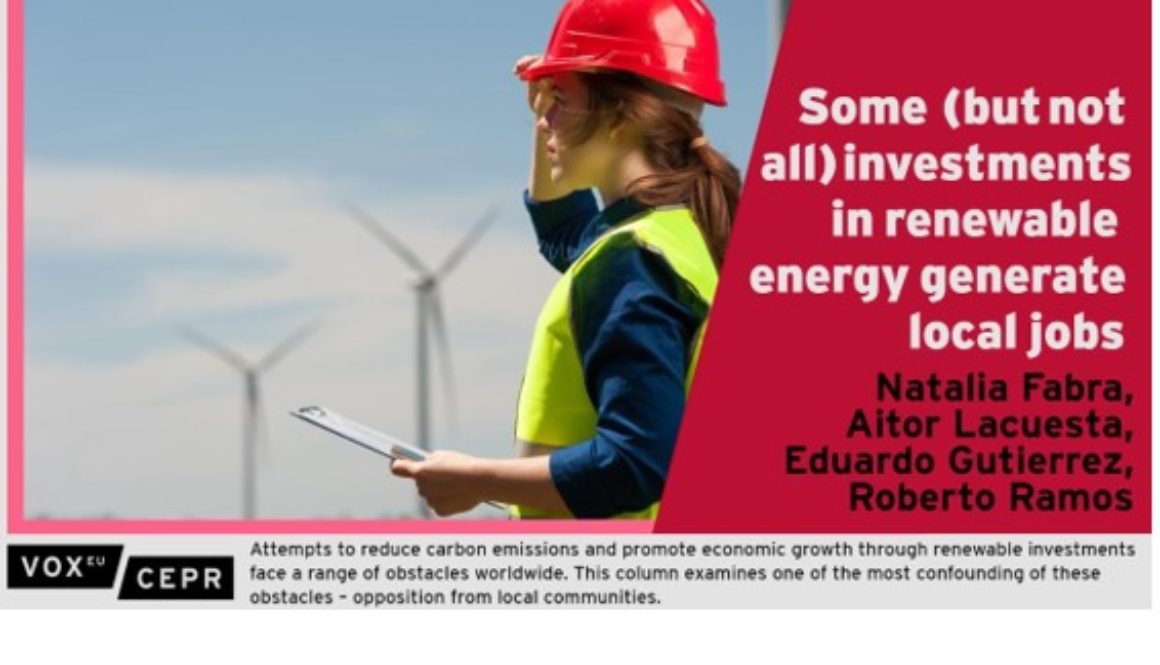Attempts to reduce carbon emissions and promote economic growth through renewable investments face a range of obstacles worldwide. This column examines one of the most confounding of these obstacles – opposition from local communities. Why do residents oppose renewable investments, even those promising socioeconomic benefits such as new jobs? Using data from across Spain, the authors find that new jobs from renewable investments do not always remain in the municipalities where the ventures are built. Public policies should therefore ensure that benefits from renewable investments are shared with the hosting communities.
A technological revolution has driven the costs of investing in renewable energies to record lows. Over the last decade, the costs of investing in solar photovoltaics and onshore wind have fallen by 88% and 68%, respectively (IRENA 2022, Newberry 2018). These cost reductions have fostered a massive roll-out of renewable energy investments around the globe, making it easier to reduce fossil fuel consumption. However, an unexpected obstacle has emerged: opposition from the local communities that host the investments. This movement, known as NIMBY (‘not in my backyard’), is responsible for blocking solar and wind developments globally.
Several papers have analysed the costs imposed by renewable energy projects on the hosting communities, including their adverse effects on land conservation and biodiversity or the crowding out of economic activities such as agriculture or tourism (e.g. Germeshausen et al. 2022). However, little attention has been devoted to understanding the other side of the equation: local benefits. Do hosting communities oppose renewable investments because of the local costs, or because they do not benefit enough to offset those costs? It is widely recognized that renewable energies bring about socioeconomic benefits. Indeed, post-pandemic recovery plans rely on green investments as a lever for economic growth and employment. If those benefits are real, but local residents still oppose the investments, does that mean the local benefits are not enough to compensate for the costs?
In recent work (Fabra et al. 2022), we use local employment and unemployment impacts as proxies for the local economic benefits of renewable investments. We exploit variations in the timing and size of investment projects across more than 3,200 Spanish municipalities using 13 years of monthly data that witnessed two major investment waves (2007–2020). We use detailed data on individual renewable projects, including their location, technology, and start-up date. These data are combined with employment and unemployment data at the municipal level. Whereas employment data capture the number of jobs by local firms, unemployment data reflect the number of local residents without a job. Combining these data sources provides a rich picture of the heterogenous local labour market effects caused by renewable investments. Methodologically, as far as we are aware, our work is the first application of Dube et al. (2022), who propose a new estimator for staggered differences-in-differences analysis that extends the local projections approach (Jordá 2005) with clean controls.
Importantly, we find significant differences in the local job multipliers across renewable technologies. Whereas investment in solar photovoltaics has sizeable multipliers, investment in wind triggers no statistically or economically significant local job creation. The mechanisms that explain these differences are related to the types of tasks and skills required to carry out the projects. In the case of wind, investments are front-loaded and not necessarily local, as high-skilled workers are required to carry out the projects, which they often do from elsewhere. Solar investments require less specialised skills, allowing the project developers to hire workers locally. Furthermore, the construction of solar farms, which has a strong local component, bears a higher weight in the project’s total cost. Consistent with this, we also find that the labour market effects of solar investments concentrate primarily during the construction phase and become milder during the maintenance phase. These findings align with the International Renewable Energy Agency (IRENA)’s 2021 assessment: “The integration of local content and local employment remains a challenge, particularly in wind energy”.
Figure 1 illustrates the employment effects across technologies and periods. The x-axis reflects the number of months before or after the start-up date (marked by a solid red line). By that date, the plant must be ready to produce electricity, so treatment must have begun approximately 24 months before, when construction is expected to have started (marked by a dashed red line). The y-axis shows the value of the job multipliers per MW invested (a similar pattern is found per million euros invested).
In the case of solar investments, multipliers become positive and significant approximately 22 months before the start-up date, consistent with the start of construction, and peak at around seven months before that date, when the major construction work is finished. Later multipliers decrease but only partially vanish, reflecting labour needs during the maintenance phase. The average local multiplier one year before the end of construction is 2.5 workers/MW (or 0.8 workers/million € invested) and 1.5 workers/MW during the maintenance phase (or 0.2 workers/million €). These local multipliers are in line with those found for fracking in the US (Feyrer et al. 2017). In the case of wind, the local employment multipliers are not different from zero, during both the construction and maintenance phases. Using a more standard event-study design delivers broadly similar results.
Figure 1 Local employment effects of solar and wind investments
Notes: These figures show the effects of investing 1 MW on employment by firms located at the municipalities where the investment occurs in the period February 2006-January 2018, h months before or after the start-up date (marked with a vertical red line). Panel (a) shows the results for solar investments and panel (b) for wind investments. Error bands depict the 95% confidence interval. Standard errors are clustered at the municipality level.
As seen in Figure 2, the effects on employment tend to be larger than those on unemployment, suggesting that local firms hire workers in other municipalities or counties to carry out the projects. This is consistent with difficulties in finding skilled workers in the rural municipalities where most of the projects are located. The local multipliers are well below those found for other infrastructure projects in Spain (Alloza and Sanz 2021). The weak unemployment multipliers also reflect that the labour market effects are mostly confined to sectors directly linked to the construction or maintenance of the plants, in line with our sector-level analysis. Interestingly, in the case of solar, there is a slight surge after the start-up date in the number of unemployed workers who were previously employed in the construction sector. This is true even relative to the pre-construction period. This finding is consistent with the project attracting new residents to work on the plant’s construction who become unemployed once construction ends.
Figure 2 Local unemployment effects of solar and wind investments
Notes: These figures show the effects of investing 1 MW on unemployment by residents in the municipality where the investment occurs in the period June 2008-January 2018, h months before or after the start-up date (marked with a vertical red line). Panel (a) shows the results for solar investments, and panel (b) for wind investments. Error bands depict the 95% confidence interval. Standard errors are clustered at the municipality level.
The relatively small magnitude of the local effects, particularly in wind investments, does not mean that renewable investments do not create jobs on a broader scale. Indeed, it is plausible that a significant fraction of the employment benefits accrue away from the municipalities where the investments occur. However, since the opposition of local communities may become a bottleneck for the broader deployment of renewable energies, it is fair and efficient to distribute the gains from the renewable investments within the hosting municipalities. Promoting local energy communities so that residents have a stake in the new projects; reducing the electricity price for local residents; increasing the local taxes paid by renewable investors; prioritising grid access to those projects that promise greater local benefits… These and other options should be considered to obtain the social acceptance of renewable projects among local communities, which is necessary for their broad adoption.
This article was published at VoxEU on January 5, 2023


